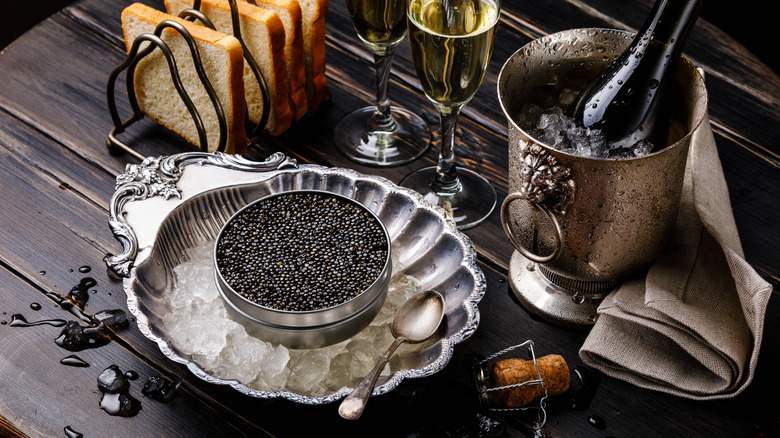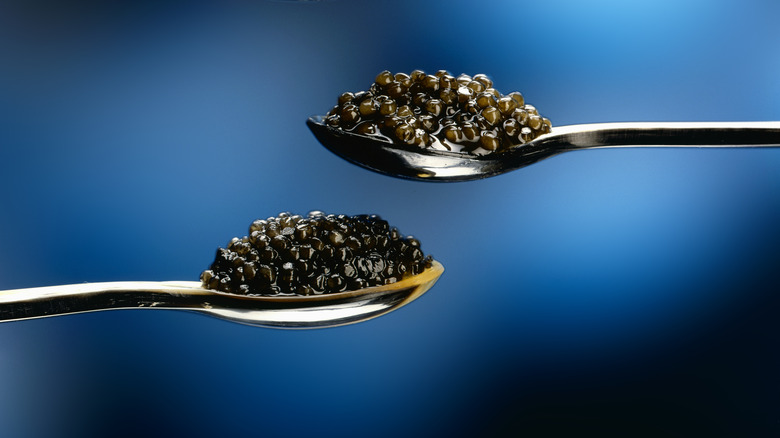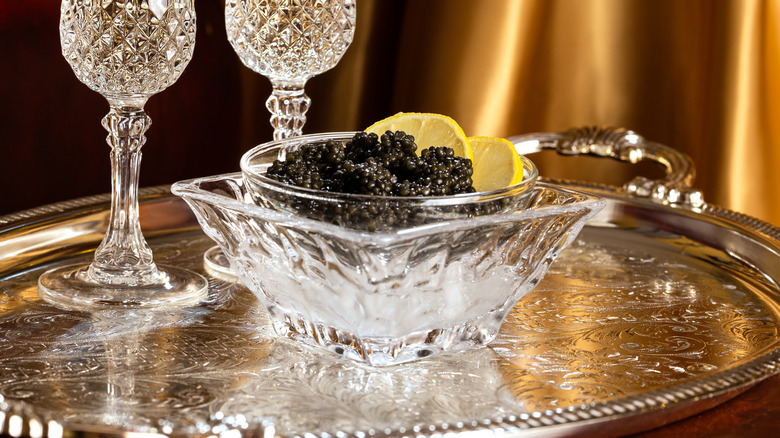Caviar Was Peasant Food In The 12th Century. Here's What Happened
There is perhaps no food more indicative of luxury than caviar. The dish consists of canned sturgeon roe that's often served over ice and scooped up with a small spoon preferably carved from mother of pearl or animal horn. Caviar has become synonymous with excess and wealth, but it was once designated as a peasant food. Caviar's culinary history dates back thousands of years; from the Byzantines to the Greeks and the Persian Empire, caviar was an abundant food in many cultures throughout history.
The dish's current status, however, is deeply rooted in Russian culture. The food gained widespread popularity in Russia during the 12th century and was particularly popular amongst Russian peasants, who consumed all parts of the sturgeon that populated Russia's Volga River and Central Asia's Caspian Sea. The fishes' roe was often cured in a salt brine to help preserve it, giving caviar its salty, oceanic taste.
Then, in the 16th century, Tsar Ivan the Terrible took a liking to the briny roe. The Tsar's taste for caviar — in particular black sturgeon caviar, which was a part of his sturgeon-heavy diet — spawned a larger taste for the food across Russia. But the shift from peasant food doesn't simply come down to one Tsar's fishy tastes. There are also more practical reasons behind caviar's high price point, namely overfishing and a labor-heavy production process.
The spawning of an industry
Ivan the Terrible did indeed shift caviar's reputation, turning the food from a peasant staple into a highly sought-after luxury good. In fact, many brands sport the name of the Romanov dynasty to market their products. But how did this dish transform from an easily available, common household staple into a rarified item?
For one, overfishing of sturgeon in the Caspian Sea, which is cradled between Russia and Iran, led to the depletion of sturgeon fish, causing a caviar shortage by the late 20th century. This caused prices to rise, and as a result, caviar became a delicacy, signifying both wealth and class.
This shortage also led to the widespread use of sturgeon farming to harvest caviar, in the hopes that wild sturgeon populations might be able to recoup from overfishing. Most caviar sold now comes from sturgeon farms. The use of fish farming has become increasingly popular over the past several decades and has helped rebuild wild fish populations. However, this sturgeon farm-produced caviar often uses additives such as borax, a mineral that's banned in U.S. food products. The influx of Chinese-farmed caviar has caused major fluctuation in the dish's price in recent years, with the cost dipping to the lowest point in recent memory during the 2010s. However, certain caviars, such as beluga caviar, are still nearly impossible to find in the United States.
The 1980s solidified caviar as a luxury item
Caviar's status as a luxury item inextricably tied to images of fur coats and stretch limousines has endured since the 1980s, and the dish has become shorthand for ostentatious displays of wealth. Of course, this reputation goes far beyond Ivan the Terrible's influence. Part of this is the labor-intensive harvesting process — in which the roe must be carefully removed from inside the fish, rinsed, and thoroughly inspected for impurities — but it's likely also related to an iconic television series. "Lifestyles of the Rich and Famous" ran from 1984 to 1995 and documented the opulent lives of many celebrities, business moguls, and athletes.
The series fed into the 1980s' growing fixation on wealth and luxury and quickly became a television staple, allowing virtually everyone in America to indulge in the finer things, even if only from afar. Perhaps the most iconic aspect of the show came from its catchphrase, "Champagne wishes and caviar dreams." This slogan embodied the series' aesthetic and signaled both champagne and caviar as rarified items.
Partly because of this catchphrase, as well as other iconic depictions of caviar in 1980s media, the food quickly became shorthand for opulent, overindulgent displays of wealth, and this reputation has endured through the decades. Even as prices have gone down and restaurants have attempted to bring caviar out of the stuffy world of the past, caviar remains, to most Americans, simply a dream.


